Swaziland National Fire & Emergency Service - travel journal
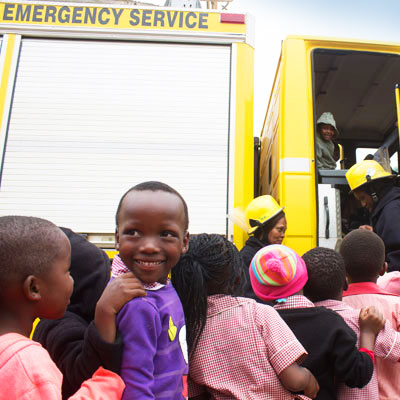
We have worked with our partner in Swaziland, All Out Africa, to devise a trip for children that attend the local Neighbourhood Care Point (NCP) centers. These centers were started by local communities and most of the children who attend have lost a parent, or in some cases are orphaned. Traveling by minibus and stopping for lunch ensures a fun-packed day out for the children plus they see some of the local heritage sites that, too often, only tourists to their country have the privilege of viewing.
This trip took 178 children aged 4-6 years old to the Swaziland National Fire & Emergency Service. The trip was carried out over 3 days: 25th, 26th & 27th October 2017 and included children from different Neighbourhood Care Points in the Swaziland area: Mvutjini, Nkhanini, Mlindazwe and Ezulwini. Each trip was accompanied by NCP staff, volunteers, All Out Africa supporting staff and cooking ladies.
Journal
Dates: 25th, 26th & 27th October 2017
We saw: The children were very happy to the see their local Fire and Emergency department. They saw lorries which they called fire engines and they were really engaged and excited to see the fire fighters outfits. They watched a demonstration of a fire truck releasing water to put out a fire and learned how dangerous fires are. The fire fighters taught the children that candles are dangerous and should always be put out at night before they go to sleep. They also learned that they should never swim near a river alone and unsupervised and that the water which is used to put out fire has a certain chemicals in it so should never be used as drinking water.
Children were showed tools that firemen use in the field, be it putting out fire or attending to car accidents on the roads. The children were also taught about lots of different scenarios, one example was if a fire has taken place and is not reachable due to a lack of a crossing bridge, the fire fighters will improvise by connecting fire pipes until it reaches the area and if there is a water shortage in their vehicle (trucks), other local fire station departments assist. They were also given a ride in the fire engine!
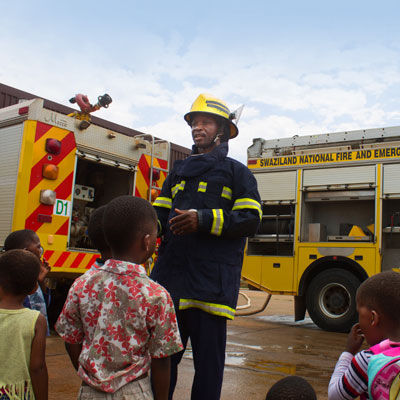
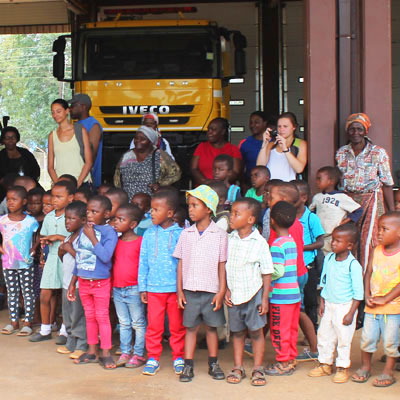
We ate: Stew beef and chicken with salad and variety of fruit juices.
Some of our favorite parts of the day were:
- Hearing the fire truck alarm
- Seeing fire men
- Seeing the firemanís truck
- Demonstration of the water pouring out from the truck was good to see
- Seeing fire fighters and their equipment, especially their uniform
- Enjoyed the lunch provided
“
- Sphesihle (age 6)
"I saw a fire man climbing up on the fire truck and he showed us a pipe which is on the top of the fire truck. Also we were shown how the water is released from the fire truck. This was exciting to see."
- Thandolwethu (age 6)
"I saw a yellow Fire Engine at the local Fire and Emergency Service department. We met the fire fighters who trained us on the day. We were also shown a step ladder. The firemen demonstrated how the water is used when putting out fire."
- Thabani Kubheka (age 6)
"We went to the Lobamba Fire department and we were trained on the danger of fire and drowning. We were also shown the water tank and associated pipe. We also saw step ladders. I enjoyed meeting the other NCP children and we enjoyed the lunch."
- Wakhile Busenga (age 6)
"Thank you so much for this exciting trip because I even learnt a lot from this trip and fire fighters were very patients with us. Now I know that when they rescue people in an accident they use specific machinery. I was thinking that there were using axes and bush knifes, but now I know. Thank you, thank you!!!!!!"
- Teacher Mgazi
"In conclusion, we were very happy to have learnt a lot on this field day at our local fire and emergency department. We really thank All Out Africa and Responsible Travel for such an amazing day for the kids and me as well. This has really set a good picture for all the children in learning more on fire safety and emergency. Thank you, thank you, thank you."
- Ezulwini NCP staff
”
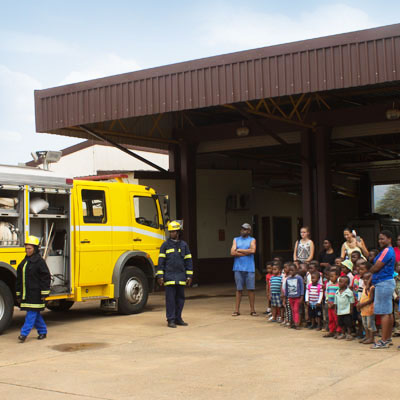
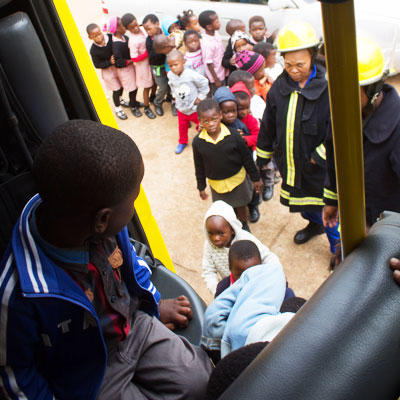
About Swaziland's National Fire & Emergency Service
Mission: The mission of the Swaziland National Fire and Emergency Service is ďto promote fire prevention, ensure timely suppression of fire and provision of humanitarian services under emergency situations to minimize the risk impact and consequences of an emergency or disaster to life and property throughout the Kingdom.
Duties and responsibilities: The departmentís essential vision and number one priority is to provide an efficient and effective fire fighting and rescue service that is capable of combating all types of emergencies or disastrous situations using the limited resource in the interest of public safely. The departmentís functions include that of ensuring that Fire stations are sufficiently manned, equipped in order to respond effectively to all emergencies in fulfillment of the objectives set out in the Kingís order in Council No. 14 of 1975.
Background and responsibilities:
In response to increasing urbanization, the Government of Swaziland in 1991 created an urban portfolio and merged it with the housing portfolio to establish the Ministry of Housing and Urban Development. The portfolios were given the following responsibilities:
- Housing and human settlements
- Physical and town planning
- Water and sewerage
- Rents
- Land for residential purposes
- Urban governments
- Fire and emergency services
In 1996, the portfolio and responsibility allocations were revised to become: Housing and human settlements
- Physical planning/town planning
- Private townships approval
- Sectional titles development
Urban governments
- Urban local government administration
- Infrastructure development and maintenance
- Refuse collection and disposal
- Building plans approvals
- Vacuum tanker services (including sewerage disposal)
National fire and emergency services
- Fire fighting services
- Emergency rescue services
- Fire training services
- Fire prevention services
- Paramedic services
- Water retrieval services
The Ministryís institutional structure consists of four main Departments, namely Administration, the Department of Housing and Human Settlements (DHHS), the Department of Urban Government (DUG) and the Fire and Emergency Service Department. There is also a housing parastatal, Swaziland National Housing Board (SNHB), the two Municipal Councils of Mbabane (Mbcc) and Manzini (Mzcc) and the ten Town Councils for small towns.
 About our partner organisation: All Out Africa is a social enterprise comprising of a group of companies and a non-profit based in South Africa, Swaziland, Mozambique and Botswana. It caters to people looking for a wide variety of African experiences from volunteering, tours, research, internships, and university field studies, whilst at the
same time, building sustainable long-term projects.
About our partner organisation: All Out Africa is a social enterprise comprising of a group of companies and a non-profit based in South Africa, Swaziland, Mozambique and Botswana. It caters to people looking for a wide variety of African experiences from volunteering, tours, research, internships, and university field studies, whilst at the
same time, building sustainable long-term projects.
All Out is serious about giving back to the community and the environment. That is why they set up a foundation to help expand and sustain their project development, which include support to the six care centers for vulnerable children, a sports development program for local children and youth, community building projects, child sponsorship program to support vulnerable children at primary and high school levels to assist them with school requirements, and facilitate conservation research projects at the wildlife and marine research centers. All Out shares their passion for Southern Africaís people, places and wildlife with the world and offers adventures that change lives.
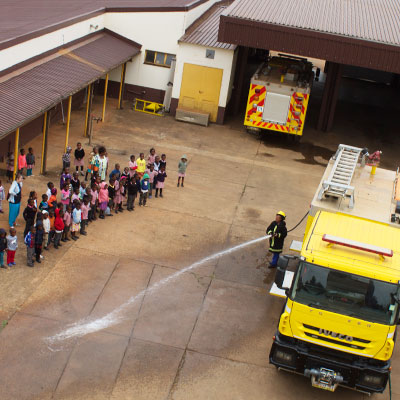
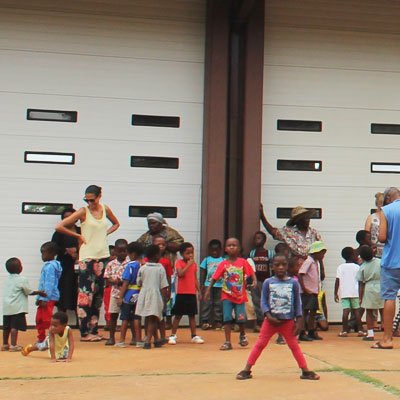


More about Trip for a Trip
- Read more about Trip for a Trip and other trips we've run.
- If you've booked a vacation via Responsible Travel, claim your booking gift to join our Trip for a Trip scheme.




